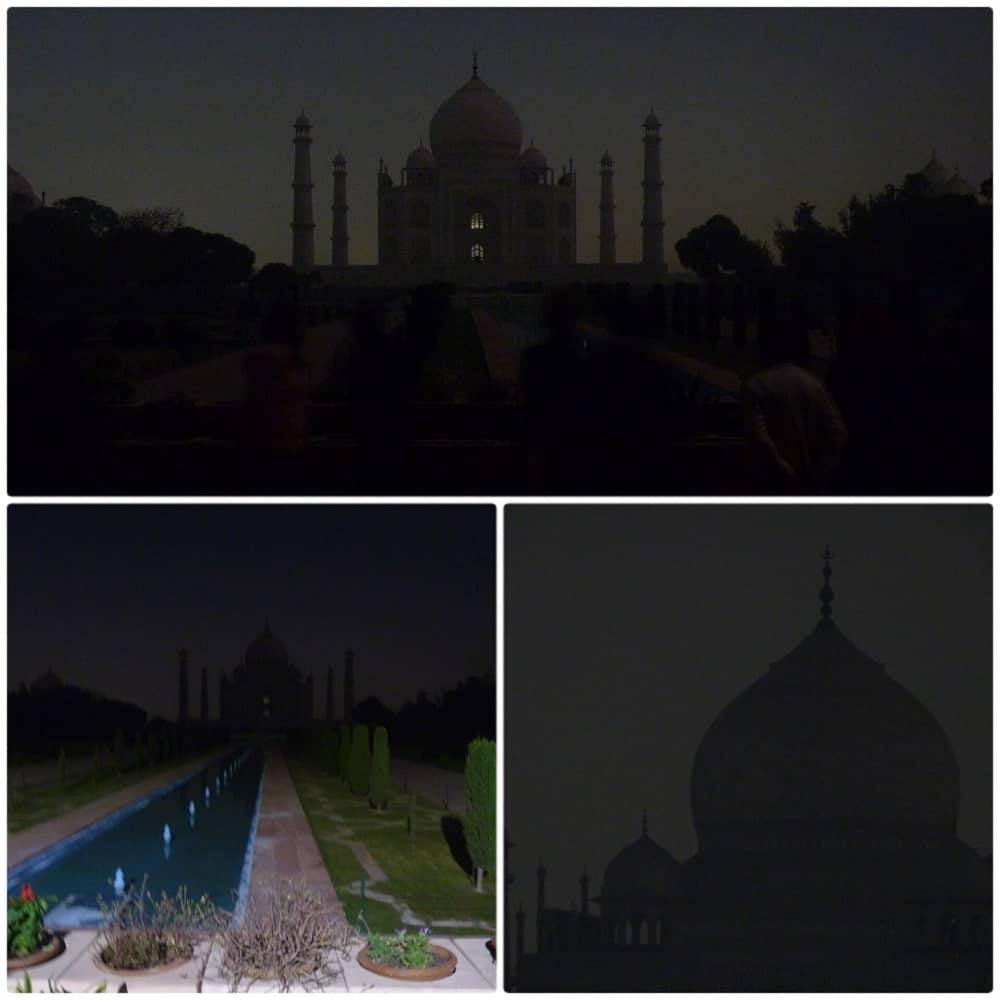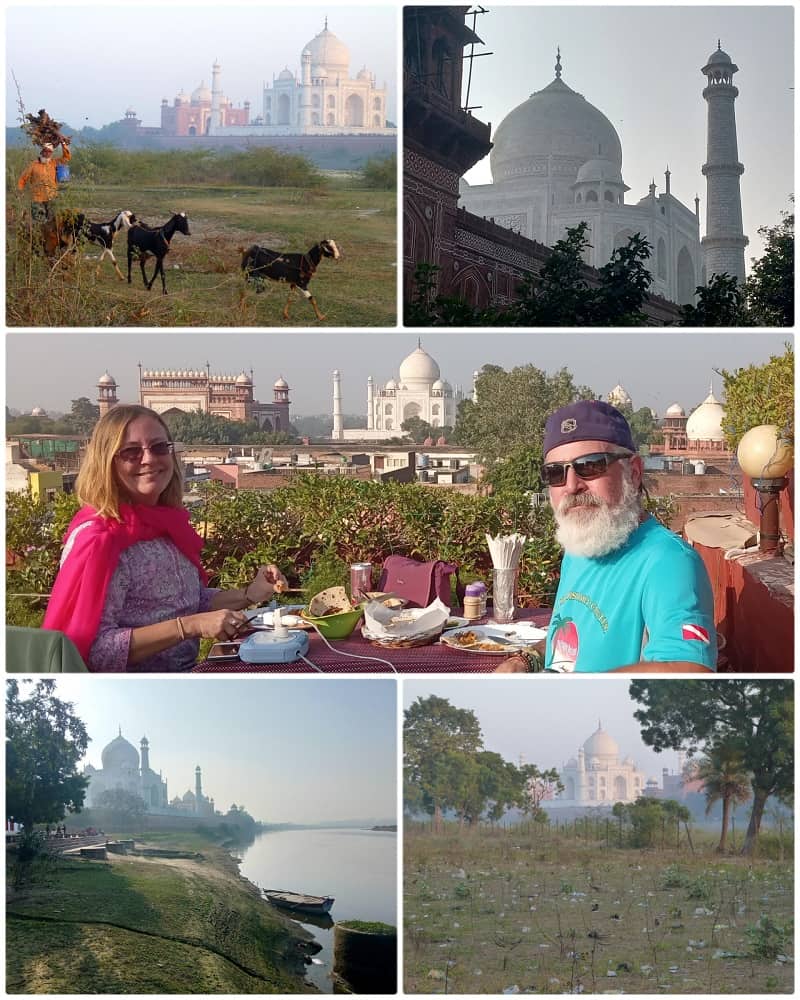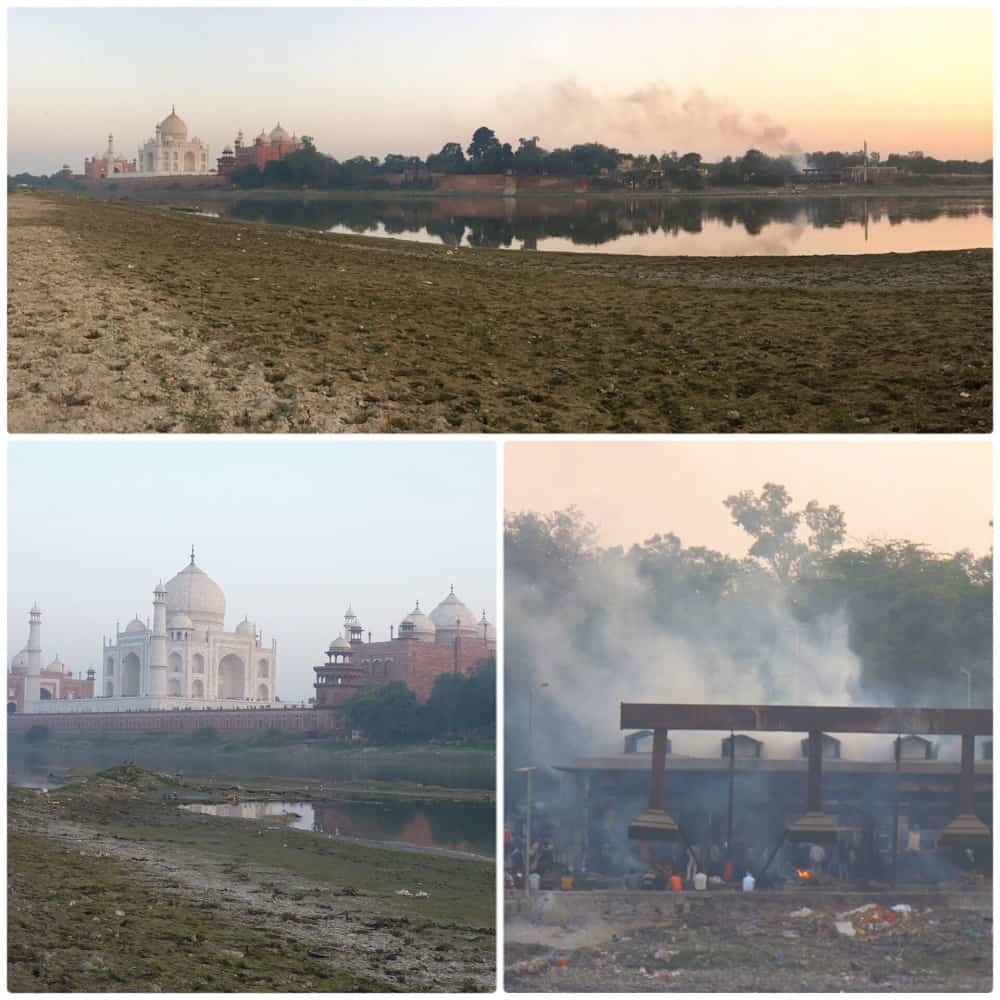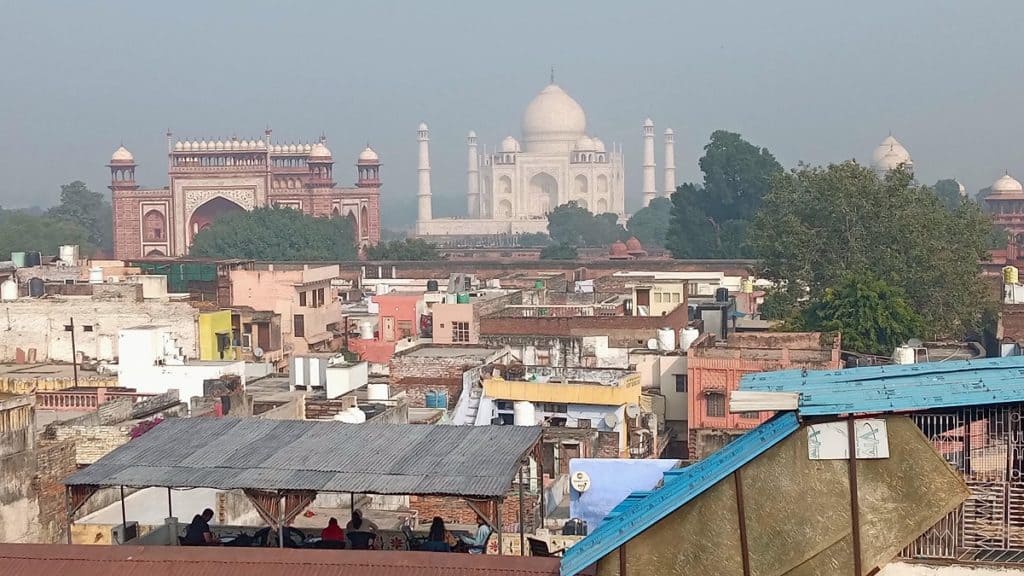Last Updated on October 25, 2024 by Ellen
The most mesmerizing building on the planet: the Taj Mahal, located in Agra, India. That is my opinion after spending days observing, exploring, and experiencing the place.
As one of the ‘Seven Wonders of the World’, I’ve long admired photos of the Taj. And being an early retired world-wanderer, it’s always been on my ‘must see list’. Still, I’m amazed by how truly beautiful and enchanting the structure is.
My wife says the renaissance sculpture ‘David’ by Michelangelo in Florence, Italy, is the most exquisite work of art ever created. To me, the Taj Mahal is its equal in terms of architecture.
We’ve already posted two articles about the Taj to our blog. One for the trip cost over four nights, and the other for the ‘love story’ behind the world’s most famous mausoleum.
What follows is more information and observation for anyone with further interest in this magnificent treasure.
- 10 truths, troubles & takeaways
Taj Mahal info: 10 truths, troubles & takeaways

1. The recognized facts
The Taj Mahal was built by Mogul Emperor, Shah Jahan, as the final resting place of his third and favorite wife, Mumtaz Mahal, who died giving birth to their 14th child.
The complex took over 20 years to build — starting in 1632. More than 20,000 workers and 1,000 elephants reportedly worked on the project. Construction of the 42-acre mausoleum complex cost the equivalent of $1 billion today.
The site is visited by 5 to 8 million people annually, sometimes more than 50 thousand per day. It is the most popular tourist attraction in India. We witnessed far smaller crowds weekdays in December 2022. International tourism remains depressed thanks to COVID.
2. Pollution problems / conservation
Since the 1980’s, efforts have been underway to protect the Taj. Yellowing and other environmental damage to the lustrous white marble has resulted in various restrictions. Air polluting factories in the region have been closed, moved, or converted to natural gas inputs. Petrol burning automobiles are banned within 500 meters of the Taj grounds. Open fires, the burning of wood, organic waste, or garbage forbidden too.
In 2022, the Indian Supreme Court ruled ALL commercial activity in the same 500 meter zone must cease: the ruling later modified to prohibit only new or expansion of businesses.
3. A foundation issue?
Another conservation concern: the Taj Mahal foundation. Built at the edge of the river Yamuna meant an extra deep ‘well’ foundation was designed to support the weight of the massive structure. Those support pilings reportedly include wooden beams. When submerged in water, wood can last for many centuries – as it has. But changes in the river, a lower water table, and climate change in general are developing issues that could affect the wood – and the Taj.
4. No lighting at night
The Tah Mahal is void of any artificial light. Lighting the structure at night would attract untold insects. Excrement from said insects would degrade surfaces. A Yanni music concert held in 1997, which included lighting the Taj, validated the concern. However, ambient Agra city light creates a magical night time silhouette effect viewable from many rooftops, terraces, and other viewpoints.

5. Moonlight viewing sessions
For five eves during the full moon, night-time Taj Mahal viewings are offered. The exceptions are no Fridays, when the Taj is closed, and there is no night viewing during the month of Ramadan.
We attended. For 750 rupees ($9) per person, 50 guests at a time are escorted for 30-minute, strictly-controlled, distant gazes from just inside the main gate between 8 PM and midnight. Unfortunately, at our 10 PM slot, the moon wasn’t ‘high enough’ to cast much light on our south-facing building front.
How to get moon viewing tickets
Moon viewing tickets are procured at the Archeological Survey of India offices at least the day before the viewing. The office is a 15 minute tuktuk ride from the Taj. Or, you can buy tickets through a tour agent with a big markup.
You need to bring a color copy of your passport when you buy the tickets. The Indian government is strict about buying tickets with these rules and others. More information on night viewing and tickets is on the official site.
Is the night view worth the hassle?
My opinion: the moon viewing was pretty cool and somewhat romantic (with 50 other people close-by) – but very short and restrictive; not a ‘must do’.
Cell phones are NOT permitted at night; ‘real’ cameras only, but no tripods or flash allowed.
6. Daytime visits: the real attraction
The Taj Mahal gates – east & west – open daily (closed on Fridays) about 6:30 AM. We were at the nearby ticket booth by 6:00 (second in line – cash only), and inside by 6:45 AM. Tickets are 50 rupees (63 cents) for Indians and 1100 rupees ($13.30) for foreigners. Entrance to the mausoleum – the Taj Mahal building – is 200 rupees ($2.50) extra for everyone — A MUST DO! Required, protective, over-shoe, cloth booties are included with the mausoleum fee. Visitors were not limited on the length of time allowed on the grounds during our visit, but posted signs said there was a three-hour limit.
Note: Online ticket purchases are possible and encouraged – but our U.S. credit card repeatedly failed, a reportedly common occurrence.
Dawn was just breaking upon our entry to the grounds. Seeing the Taj in the changing morning light is incredible! The approach walkways, gardens, platforms, and fountain pools are largely vacant; best time for deserted-looking photos. Sunrise provides further stunning views and pictures. The early hours are cooler, with few people, and quickly changing light and colors. The crowds and heat build throughout the day.

Inside the building: a very small tour space – a 360 degree loop around two ‘fake’ tombs installed inside an ornate octagonal white-marble ‘screen’. The real graves lie in a plain cellar below (open yearly for Islam urs commemorations). Signs say ‘no photos’ – but everyone seemed to be taking cell phone pics. Credentialed ‘guides’ float around the area offering detailed information about the interior space for tips.
7. Taj Mahal views from elsewhere
There are countless fantastic viewing angles from inside the Taj complex. But tremendous looks and photos can be gathered from many spots outside of the walls. There are walkable public access points immediately on each side of the Taj, at the riverfront.
Up and down and across the river exist great – and mostly free – viewpoints with few tourists. Boats are generally prohibited, but one single old-timer has a ‘grandfathered’ rowboat. We toyed with hiring him. Riding or walking near the Taj can also produce unexpected glimpses of the dome and towers – often with mind-blowing ‘other content’. Pure India!

8. The city of Agra
We were warned: Agra is ‘a pit’. But honestly, we found it cleaner than many places in India and equally friendly. It is obvious, authorities are serious about the ‘500 meter zone’. We noted the daily cleaning, hospitality, and security efforts. Touts were a bit aggressive at times, but similar to other world-class tourist attractions. Overall, the air was breathable, the smells manageable, the prices very reasonable, the views — unforgettable.
9. Nearby funeral pyres
I’ve mentioned the efforts to curtail airborne pollutants near the Taj Mahal. That’s why we were surprised to see a continuous late afternoon stream of smoke wafting directly into the west side of the building from a source less than 200 meters away on the riverfront. We photographed what we found out later were Hindu funeral pyres which have been in use for generations and continue today, despite attempts to relocate the Moksh Dham crematorium facility since 1994. Yes, 1994!
Locals told us there is fierce resistance to any crematory relocation plan and even the use of ‘cleaner’ electric incinerators. Meanwhile, India’s Supreme Court has directed the state and local governments to act for decades. Yet every evening, the smoke from burning bodies continues to directly impact the glorious Taj Mahal. Unbelievable. Pure India!

10. Politics; Hindu & Muslim
The refusal to move the historic Hindu cremation facility seems like political/cultural spite. To be clear, the Taj was built by a Muslim emperor 400 years ago. Yet, in recent years, Hindu nationalists have suggested it was a Hindu temple before the emperor ‘repurposed’ it. Lawsuits have asserted there are Hindu relics concealed inside. Most historians – and the courts – have dismissed such suggestions. The building is literally covered in Persian/Arabic calligraphy quotes from the Koran. The word ‘Allah’ is present 99 different times.
Still, apparently to some portion of the Hindu majority population, even the effort to save the Taj Mahal – a national jewel, but Muslim creation – is not cause to interrupt their age-old religious rituals, or allow them to be moved elsewhere. Such is the unease between Hindu and Muslim in this nation. Sadly, it makes one wonder how serious and effective any conservation plan truly is.
In the end…
In the end, there is nothing we as outsiders can do if the Indians cannot agree on how to safeguard their most visited shrine. (Incidentally, security at the Taj is some of the tightest we’ve seen in the country.) We can only marvel and appreciate the incredible structure while they figure it out.
Lastly, as believers in the goodness of humanity, we hope the aura of love and beauty which make the Taj Mahal the true wonder that it is will allow this ethereal edifice to endure for hundreds of years and generations more.
As always, be thankful and generous, happy trails & more beer.
Life is NOW!
Thanks for reading, “Taj Mahal info: 10 truths, troubles & takeaways.”
Other posts about Wonders of the World and UNESCO Heritage sites:
- Picnic at the Colosseum — and other budget travel tips for Rome
- Visit Angkor Wat and help locals (updated in late 2022)
- Tikal: amazing Mayan ruins in Guatemala
- Cost to see Komodo dragons in Indonesia (before the new rules)

